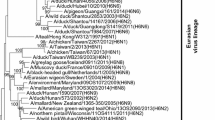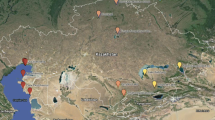Abstract
The Izumi plain in Kagoshima prefecture, Japan, is an overwintering site of more than 10,000 cranes. The wet paddy areas are artificially created to provide roosting sites for the cranes every winter. Since wild ducks, known to be a natural reservoir of influenza A viruses, also overwinter in this area, the cranes’ roost water likely serves as a source of influenza A virus infection. To assess this potential risk, we collected 126 water samples from the cranes’ roost in the 2012/2013 winter season for virus isolation. We isolated six influenza viruses of three subtypes (H3N8, H4N6, and H4N8) from the water samples collected in the months of November and December. Genetic analysis of our isolates indicated that these viruses were genetically similar to the low-pathogenic avian influenza viruses circulating among Eurasian waterfowl. These findings suggest the possibility of the cranes becoming infected with the avian influenza viruses that are present in their roost water.











Similar content being viewed by others
References
Brown JD, Swayne DE, Cooper RJ, Burns RE, Stallknecht DE (2007) Persistence of H5 and H7 avian influenza viruses in water. Avian Dis 51:285–289
Brown JD, Goekjian G, Poulson R, Valeika S, Stallknecht DE (2009) Avian influenza virus in water: infectivity is dependent on pH, salinity and temperature. Vet Microbiol 136:20–26
Curran JM, Robertson ID, Ellis TM, Selleck PW, O’Dea MA (2013) Variation in the responses of wild species of duck, gull, and wader to inoculation with a wild-bird-origin H6N2 low pathogenicity avian influenza virus. Avian Dis 57:581–586
Dugan VG, Chen R, Spiro DJ, Sengamalay N, Zaborsky J, Ghedin E, Nolting J, Swayne DE, Runstadler JA, Happ GM, Senne DA, Wang R, Slemons RD, Holmes EC, Taubenberger JK (2008) The evolutionary genetics and emergence of avian influenza viruses in wild birds. PLoS Pathog 4:e1000076
Hall JS, Franson JC, Gill RE, Meteyer CU, TeSlaa JL, Nashold S, Dusek RJ, Ip HS (2011) Experimental challenge and pathology of highly pathogenic avian influenza virus H5N1 in dunlin (Calidris alpina), an intercontinental migrant shorebird species. Influenza Other Respir Viruses 5:365–372
Hatchette TF, Walker D, Johnson C, Baker A, Pryor SP, Webster RG (2004) Influenza A viruses in feral Canadian ducks: extensive reassortment in nature. J Gen Virol 85:2327–2337
Hoffmann E, Stech J, Guan Y, Webster RG, Perez DR (2001) Universal primer set for the full-length amplification of all influenza A viruses. Arch Virol 146:2275–2289
Ito T, Okazaki K, Kawaoka Y, Takada A, Webster RG, Kida H (1995) Perpetuation of influenza A viruses in Alaskan waterfowl reservoirs. Arch Virol 140:1163–1172
Lebarbenchon C, Yang M, Keeler SP, Ramakrishnan MA, Brown JD, Stallknecht DE, Sreevatsan S (2011) Viral replication, persistence in water and genetic characterization of two influenza A viruses isolated from surface lake water. PLoS One 6:e26566
Macken CA, Webby RJ, Bruno WJ (2006) Genotype turnover by reassortment of replication complex genes from avian influenza A virus. J Gen Virol 87:2803–2815
Olsen B, Munster VJ, Wallensten A, Waldenstrom J, Osterhaus AD, Fouchier RA (2006) Global patterns of influenza a virus in wild birds. Science 312:384–388
Ornelas-Eusebio E, Obregon-Ascencio A, Chavez-Maya F, Garcia-Espinosa G (2015) Molecular characterization of an influenza A virus (H4N2) isolated from waterfowl habitats in the State of Mexico. J Vet Med Sci 77:365–369
Ozawa M, Matsuu A, Tokorozaki K, Horie M, Masatani T, Nakagawa H, Okuya K, Kawabata T, Toda S (2015) Genetic diversity of highly pathogenic H5N8 avian influenza viruses at a single overwintering site of migratory birds in Japan, 2014/15. Euro Surveill 20:15–27
Shi J, Gao L, Zhu Y, Chen T, Liu Y, Dong L, Liu F, Yang H, Cai Y, Yu M, Yao Y, Xu C, Xiao X, Shu Y (2014) Investigation of avian influenza infections in wild birds, poultry and humans in Eastern Dongting Lake. China. PLoS One 9:e95685
Sinnecker R, Sinnecker H, Zilske E, Kohler D (1983) Surveillance of pelagic birds for influenza A viruses. Acta Virol 27:75–79
Stallknecht DE, Kearney MT, Shane SM, Zwank PJ (1990) Effects of pH, temperature, and salinity on persistence of avian influenza viruses in water. Avian Dis 34:412–418
Stallknecht DE, Shane SM, Kearney MT, Zwank PJ (1990) Persistence of avian influenza viruses in water. Avian Dis 34:406–411
Webster RG, Yakhno M, Hinshaw VS, Bean WJ, Murti KG (1978) Intestinal influenza: replication and characterization of influenza viruses in ducks. Virology 84:268–278
Webster RG, Bean WJ, Gorman OT, Chambers TM, Kawaoka Y (1992) Evolution and ecology of influenza A viruses. Microbiol Rev 56:152–179
Wright PF, Neumann G, Kawaoka Y (2007) Orthomyxoviruses. In: Knipe DM, Howley PM, Griffin DE, Lamb RA, Martin MA, Roizman B, Straus SE (eds) Fields Virology. Wolters Kluwer; Lippincott Williams & Wilkins, Philadelphia, Baltimore, New York, London, Buenos Aires, Hong Kong, Sydney, Tokyo, pp 1691–1740
Yuan R, Cui J, Zhang S, Cao L, Liu X, Kang Y, Song Y, Gong L, Jiao P, Liao M (2014) Pathogenicity and transmission of H5N1 avian influenza viruses in different birds. Vet Microbiol 168:50–59
Zhang H, Xu B, Chen Q, Chen J, Chen Z (2011) Characterization of an H10N8 influenza virus isolated from Dongting lake wetland. Virol J 8:42
Zhang H, Li Y, Chen J, Chen Q, Chen Z (2014) Perpetuation of H5N1 and H9N2 avian influenza viruses in natural water bodies. J Gen Virol 95:1430–1435
Acknowledgments
We thank the Ministry of the Environment, the Prefecture of Kagoshima, and the City of Izumi for sampling the cranes’ roost water. This work was supported by a Grant-in-Aid for Research on Emerging and Re-emerging Infectious Diseases from the Ministry of Health, Labour and Welfare, Japan; by a Grant-in-Aid for Challenging Exploratory Research from the Japan Society for the Promotion of Science (JSPS) (JSPS KAKENHI Grant Number 26670227); and by contracted research activity for crane conservation with the City of Izumi, Japan. This research was commissioned by the Kagoshima Crane Conservation Committee.
Author information
Authors and Affiliations
Corresponding author
Rights and permissions
About this article
Cite this article
Okuya, K., Kawabata, T., Nagano, K. et al. Isolation and characterization of influenza A viruses from environmental water at an overwintering site of migratory birds in Japan. Arch Virol 160, 3037–3052 (2015). https://doi.org/10.1007/s00705-015-2610-0
Received:
Accepted:
Published:
Issue Date:
DOI: https://doi.org/10.1007/s00705-015-2610-0




